
|
Jersey. Channel Islands, Great Britain / New Zealand
|
|
About Jersey |
|
Troy family history |
|
My family |
|
Our home |
|
Our horses & animals |
|
Morris Minors & Vmax |
|
E.Troy Ltd |
|
The occupation years |
|
Shuttlers Badminton |
|
Interesting snippets |
|
Contact us |
|
What's New |
|
Links |
|
Guest book comments |


|
©Troy Family publications 2001-24 All rights reserved
|
|
Updated every 3 months . Last update Jan 2024
|
|
Jersey |
|
March 24 |
|
Website administrator Maurice R. Troy |
|
If you have any comments you would like to add about anything on this website please contact the website administrator.
maurice@troyfamily.co.uk |
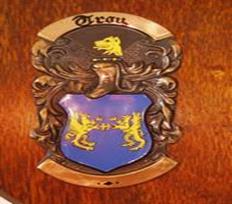

|
Website administrator Maurice R. Troy |


|
Edward Troy 1860-1924 Sarah Troy 1862-1925 |
|
Below is some interesting information obtained by my late cousin Brigadier Terence M. Troy. CBE. and passed to me.
At the bottom I have researched the Troy’s from America, Britain, Canada, Australia and New Zealand who were killed and are still buried overseas from World war 1& 2 with names ages and origins , some of the graves I have visited. |
|
Way back in the 1840’s or 1850’s a number of Troys from our Troy part of Ireland undoubtedly went to Australia. I know, from what my father told me, that the family in Jersey kept in touch with those in Australia for many many years but unfortunately the link broke when I think my father’s aunt, Bridget, died. It is interesting to note that sometime in the 1850’s we saw mention in the newspapers of a Troy who was a cabinet minister in one of the Australian State Governments. A great many Troys emigrated to America. Some of these undoubtedly from our part of Ireland but also many from other Troy families.
In reading a history of the American Civil War I noted with interest that there were two Troys mentioned, both of them Lieutenant Colonels commanding infantry regiments, one on the Northern side and the other on the Southern confederate side. I also noticed on a visit to the Pentagon at Washington that some four or five Troys in the history of the United States Army had been honoured with the United States highest award of its Congressional Medal of Honour, which, I understand, is something like our Victoria Cross. Just one note of caution - although I think the majority of Troys in America probably came from the same clan as ourselves, there is one other family of Troys in America who are certainly nothing to do with us. I don’t think there are many of them but they belong to a family which came over from France to Londonderry in Northern Ireland. They were Huguenots and I think were weavers. I think they came from the French town of Troyes and came over at a time when the Huguenots in France were being persecuted. They all settled in Londonderry but apparently didn’t care for life in Northern Ireland and at some stage the whole family upped sticks and moved to America. One of those Troys sent me a copy of their family tree which shows that quite a number of them were also involved in the American Civil War. I mentioned I think earlier on that there are Troys in Ireland, mostly I think around Dublin, who are not part of our clan. They are the Norman Troys. Originally I think their name was De Troye. Grafton’s Chronicle quotes ancient documents held by Clarence, King of Arms, in 1809 as listing “one Troys” as being one of the gentlemen who came over to England with William the Conqueror in 1066. London Pipe Rolls (which I have seen) shows a Sir Hugo De Troyes as being one of the Knights dispatched to Ireland in the 1100’s (probably with Richard De Clare in 1170 or possibly with Henry II in 1172). Henry, in 1172, made grants of lands to the Knights who came with him. Certainly in 1279 Richard Troy was mentioned when the Earl of Pembroke is re-granted lands in Ireland. He is shown as doing half Knight’s homage and is shown against Bablorkan and Drumdelgyn in Kilkenny.
Through history we see mentions of Troys for example in 1285 to 1296 Abbot Philip Troy is Abbot of St. Mary’s Abbey, Dublin. In the period 1286 to 1292 John Troy (Troye), Robert de Troye, Nicholas Troy and John Troy are mentioned, in Dublin, in Patent Rolls in connection with “visne”. The King was the sole importer of wine and “visne” is believed to be the release of wine to the King’s subjects on payment of customs due. In 1291, Theobald de Troye and his Irishmen are mentioned in the Rolls on several occasions - once for unjustly detaining a man!. In 1297 the Villata of Troy, Dublin, was fined one mark by the King for a transgression. In 1307 among the Jurors who gave witness re: the extent of land owned by the Countess of Gloucester was Theobald Troy and Richard Troy. In 1347 John de Troye was appointed Second Baron of the Exchequer of Dublin by King Edward 111 and in 1349 John de Troye was appointed Chancellor of the Church of St. Patrick, Dublin. In 1 500 Abbot John Troy was abbot of Mellifont. All very interesting but in my view these were probably Norman Troys.
The noted Chronicler of Irish Families Mac Lysight, says that the O’Trehy or O’Troy (in Gaelic) O’Troighthigh) were a County Clare sept that migrated to South Tipperary. With all the upheavals and moving around in Irish history they went to, among other places County Waterford, County Cork and adjoining counties. It is interesting to note that our name as given above in Gaelic means “a foot soldier”. Then, of course, there was the famous Archbishop Troy of Dublin (1739 - 1823) in the last century. He was a very famous chap of our name, but, without doubt came from the Norman Troy family Then in Limerick we find that in 1197 Henry Troy was Provost of Limerick and between 1198 and 1463 no less than 21 Troys were sheriffs of Limerick. Which family did they come from? Why did they stop providing sheriffs in1463? Presumably, they backed the wrong side in some local troubles! I also note that in John O’Hare’s book entitled “The Irish and Anglo-Irish land and gentry” that when Cromwell came to Ireland there is a mention of Donnagh O’Trehy from the city of Limerick and he was transplanted to the overseas colonies in 1453. A James Troy was mentioned under the “involvement of the Decrees of Innocents and a Lieutenant Anthony Troy is one of the Forty-Nine officers involved in the uprising of that year. Finally in Limerick there is a suburb, which I think is now a golf course, just outside Limerick called Castle Troy which have only ruins there now. I have seen some very interesting extracts from the Irish Transportation records held in the Irish National Archives in Dublin Castle. These show amongst others that in the 1848 a George Troy was transported overseas to the colonies for seven years on the charge of perjury. A Michael Troy from County Tipperary in 1848, also seven years transportation for sheep stealing. Owen Troy, age sixteen, transported in 1841 for seven years for felony of a cap. Patrick Troy in 1837 from Dublin transported for seven years for felony of a grate. Another Patrick Troy from County Tipperary was transported for seven years in 1837 for manslaughter. Yet another Patrick Troy from County Waterford, that’s our part of the world, transported 1849 for embezzlement. A Peter Troy from County Clare again which is where our clan came from transported in 1848 for seven years for cow stealing. A Timothy Troy, 19, from County Wexford transported in 1844 for being a vagrant. Timothy Troy from County Limerick, presumably a different one, transported for seven years in 1847 for larceny. Michael Trehy from around Dublin was transported also for seven years in 1847 for an assault on a dwelling house. Catherine Trehy in 1846 seven years for stealing geese. Patrick Troy from County Tipperary age 14 transported for seven years in 1838 for stealing five cloth caps and William Trehy from Tipperary transported for seven years in 1842 for perjury and very sadly one little girl Troy, aged I think about 12, transported overseas for stealing a cap. Not all of our clan were necessarily law abiding citizens but you have to remember that at that time when the great famine was going on, people were dying and starving all over the place and that probably accounts for the crimes of stealing caps and stealing cows and what have you, that was treated in those days as a very serious crime. I’ve also seen an interesting document which is a memorial by a Catherine Trehy written to the Governor of Ireland saying she was convicted at Cork in 1846 for stealing geese and was sentenced to seven years transportation. She says she has a large and helpless family of five children to provide for without any assistance having lost their father eight years ago. She humbly implores his Excellency to extend to her his clemency and restore her once more to her afflicted children by commuting her sentence to any period of imprisonment. Unfortunately there is no record of what happened. I also have in my possession five sheets which are copies of the land and house valuations in County Waterford which took place in 1851. These show all the familiar Troy family names, Michael Troy, John Troy, Maurice Troy, Patrick Troy, William Troy, Thomas Troy, Dennis Troy, Mary Troy, Anne Troy etc. In most cases these Troys are obviously renting little huts or homesteads and a little bit of land from in most cases what are clearly English Aristocrats probably absentee landlords. There is one however for Cappoquin which shows that the chap renting it is a Michael Troy and he is renting it from a John Troy and it is a house and garden and the tax, which is quite high on that, is £1.50. William Troy rents a house from the Duke of Devonshire and pays 7/- Shillings tax on that but he also has a garden for which he pays One Shilling tax. Patrick Troy rents a house and land from a Sir Richard Keane and pays a quite high tax on this of £3.1s 5d. There is a Patrick Troy who rents from Lord Stuart Decias quite a large area of land and a house and pays the enormous tax of £60.00 and Ten Shillings. Must be quite a big area. In the Lismore area, John Troy owned or rented three or four houses with gardens and bits of land whether that was the same John Troy I don’t know. William Troy who may well have been my great-great-great-grandfather rented a house and garden and Thomas Troy who may well have been his father and our common ancestors, that’s the only one I found as far back as I could go, he also had three bits of land or house that he rented. I am particularly interested in the William Troy renting a house from the Duke of Devonshire because there is a legend which my father told me that a William Troy, who was the father of Patrick the first Troy to come to Jersey, was the steward or Bailiff of an English Lord’s estate at Lismore and that could quite easily of course be the Duke of Devonshire. There is also shown a Patrick Troy who rented a house and a bit of land from a Sir Richard Keane in the Lismore area who may well have been our ancestor who came over to Jersey, but, when the famine came along and the potatoes on it were all rotten and starvation was facing them, decided to quit and come over to Jersey. And I note under the Baptisms that in 1823 a little girl, Margaret Troy, was registered with the parents William Troy and Bridget Guinevan and in 1828 another little girl, Honora Troy, also a daughter of William Troy and Bridget Guinevan. We don’t know too much about the 1500’s and 1600’s and what we do pick up we of course are not sure whether the Troys mentioned from time to time come from the Irish part of the family or whether they are from the Norman Troys but nevertheless I note that in Kilkenny for example, the Troys were Knights in the service of the Earl Marshall and held land from him and they gave Troys Wood its name. They also gave their name to one of the three gates in the Irish town of Kilkenny which was named Troys’ gate. Edmond Troy was porter of Grimes Gate from 1537 to 1543 and Thomas Troy was protector of the sepulchre light in 1545. Patrick Troy was also porter of the gates from 1600 to 1609. James Troy was appointed under constable in 1601 and constable in 1602 and his duty was to arrest law breakers and commit them to the jail. He would also put offenders in the stocks or the pillory and chain them to the rogue’s post near the shambles where they were pelted with rotten things by the citizens. His duty also demanded the dipping of “bowdy whores, naives and Scolds” in a pool designed for that purpose. James Troy was proctor of the parish chapel in 1604 and “Sessor” of the priest’s money in 1605”. Thomas Troy was also collector of the priest’s money in 1626 and the Bailiff to receive rents in 1628. I have also got an interesting document here about a Canon Thomas Troy of County Kilkenny. I’ll try and paraphrase a bit of it. He was a Canon of the Church of Ossory and was said to have captured aJohn Hedyan a cleric of the Diocese of Cachon when that fella was returning from the Roman Court and as a result had incurred sentences including excommunication. But in spite of this he had retained his benefices. The Pope ordered the Archbishop to examine the case and Canon Troy was found guilty and deprived of his benefices. However Canon Troy appealed to the Pope on a technicality but the appeal was not upheld. Nevertheless, Canon Troy made a comeback in 1473, Pope Sixtus the Fourth named him to be on a commission with the Abbot of St. Mary’s Abbey and the Prior of St. Colombus Abbey to summon and remove some other priest from the vicarage of St. Marys. Finally a letter written by Pope Innocent the Third showed that Canon Troy, at the time of his death, was again Canon of the Diocese of Ossory at Prevendary of Aghoar. Interesting character. An interesting piece about Castle Troy in County Limerick taken from the North Munster Antiquarian Journal says that Castle Troy was never a castle it was in fact a ferry or a riverside meadow and that the owner was a Troy who was an Irish Gaele and not an Anglo-Norman. Reverting to the meaning of our surname, Troy, in Gaelic Troigh means a foot and Troightheach means a foot soldier. A small sept, that is part of a clan, the Ui Throighe existed in County Clare before 1,000 A.D. but like many other small septs at the time migrated to County Tipperary and the place name Ballytrehy exists in the Barony of Iffa and Offa in the South of the Country. Brian de Breffny in his book “Irish Family Names, Arms and Origins” states that from the Ballytrehy district some members of the sept went Southwards into County Waterford. O’Trehy is a phonetic rendering of the Irish O’Troighe and was the older anglicised form of the name. In due course and by the early 1800’s O’Trehy had become further anglicised to become the name Troy but the name Trehy still survives to the present time. It appears that before 1500 A.D. the facts indicated the Troys in the cities, particularly in Dublin, were of Norman descent while Troys or Trehys in rural areas were of Irish descent. As both branches were Catholics all suffered persecution and when the penal laws began to be relaxed in 1775 A.D. surviving Troys and Trehys were still Catholic but almost invariable poor and without any written record of their ancestral descent. Finally I have an interesting document which shows in the period 1823 to 1864 that the surname Troy was recorded in 163 parishes throughout Ireland and it gives the numbers in each of the counties. Looking at County Waterford, there were some 56 Troy's shown as renting or owning land probably most of it only very small patches in that county.
|
|
Troy Castle on the banks of the River Shannon, Castletroy, Co.Limerick |

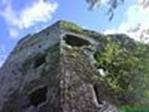
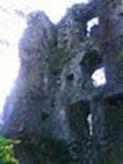
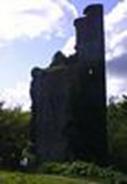
|
More interesting Australian Troy history on our family and persons mentioned on this page can be found here thanks to our distant relation Paul Troy in Australia.
Paul’s website can be found on my links page. |
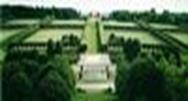
|
The massive American cemetery on the Cherbourg peninsular in France. Acres of graves that really stun anyone who visits. |
|
Valerie and I have visited some of the war graves around the world and I have researched all the military Troy surnames that are buried overseas who were casualties of World 1 & 2 |
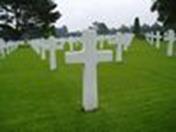
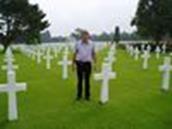
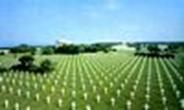
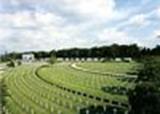
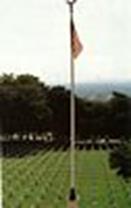
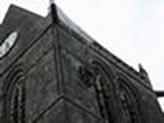
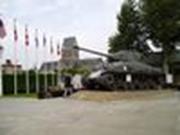
|
This is me at the grave of S Sgt Francis E. Troy from Ohio America.
And below his cross. |
|
Above: A Sherman tank at the St Mere-eglise military museum in Normandy France, well worth the visit. Taken by me.
|
|
All the American, Australian, British, Canadian and New Zealand Troy casualties buried overseas from World war 1 & 2 click here. |
|
“Take time to gather up the past so that you will be able to draw from your experience and invest them in the future.”
Quote from: Jim Rohn.
|
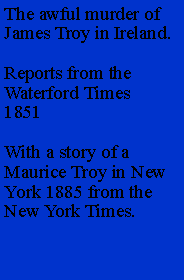
|
Is it good to seek the past or does it rob the present?
If a man dwells on the past then he robs the present but if a man ignores the past he may rob the future.
Seeds of our destiny are nurtured by the roots of our past |
|
Before you can grow and master your life you must establish your roots. Just as the tree that grows taller and stronger than all the others in the forest has the deepest roots. |
|
You can’t do much about your ancestors but you can influence your descendants enormously. |
|
Troy appearances at the Old Bailey London Central Criminal Court 1674 to 1913 |
|
Feb 2014 Some interesting information from a distant relation of mine.
You say that you are interested in the William Troy who is listed in
Thank you Sheila. For this Information. |
|
Picture below bottom right: Private John Steele, a US Paratrooper got hung up on the church during the night drop on D Day. He survived and the event is celebrated each summer by the hanging of the dummy seen here. Story here. |